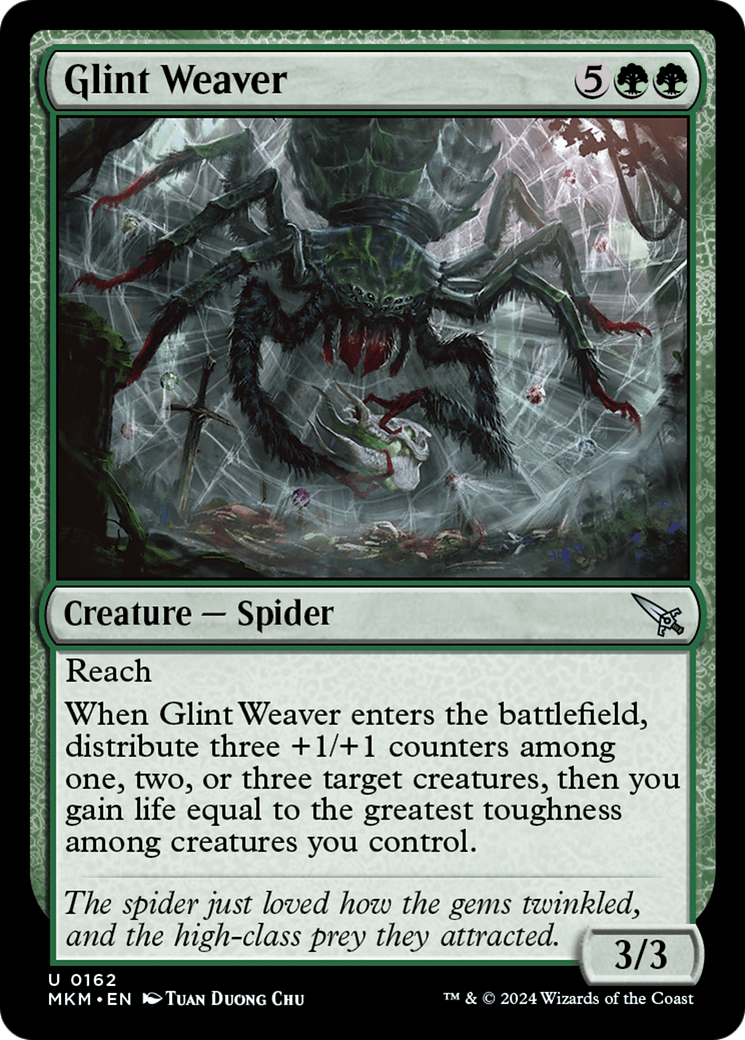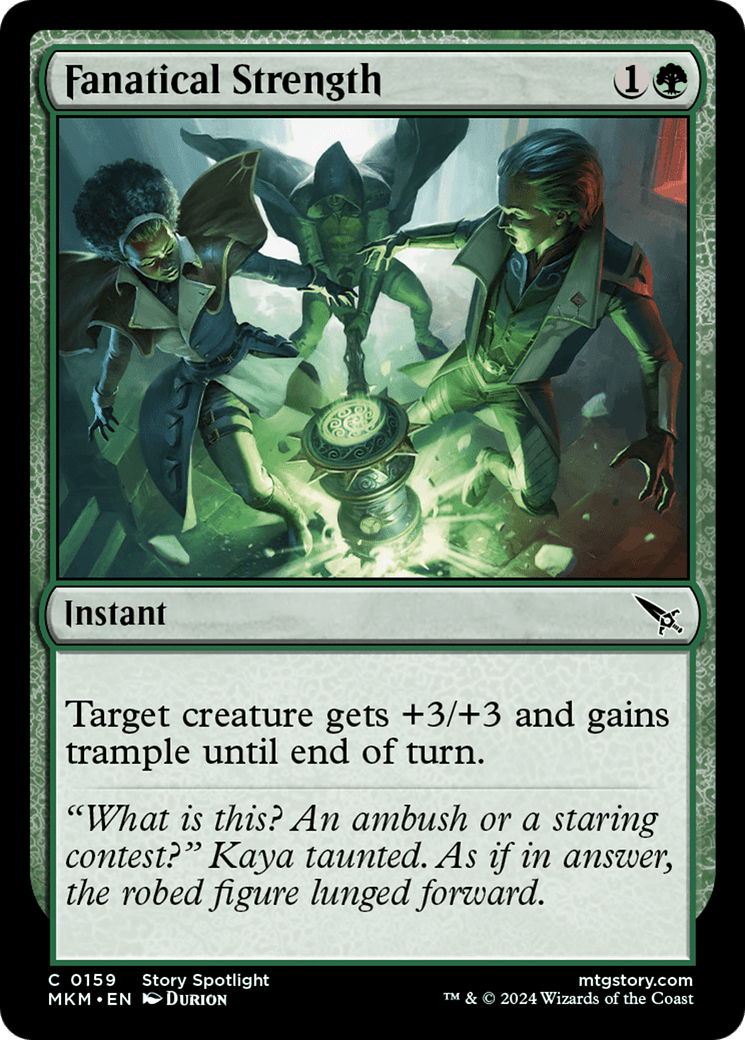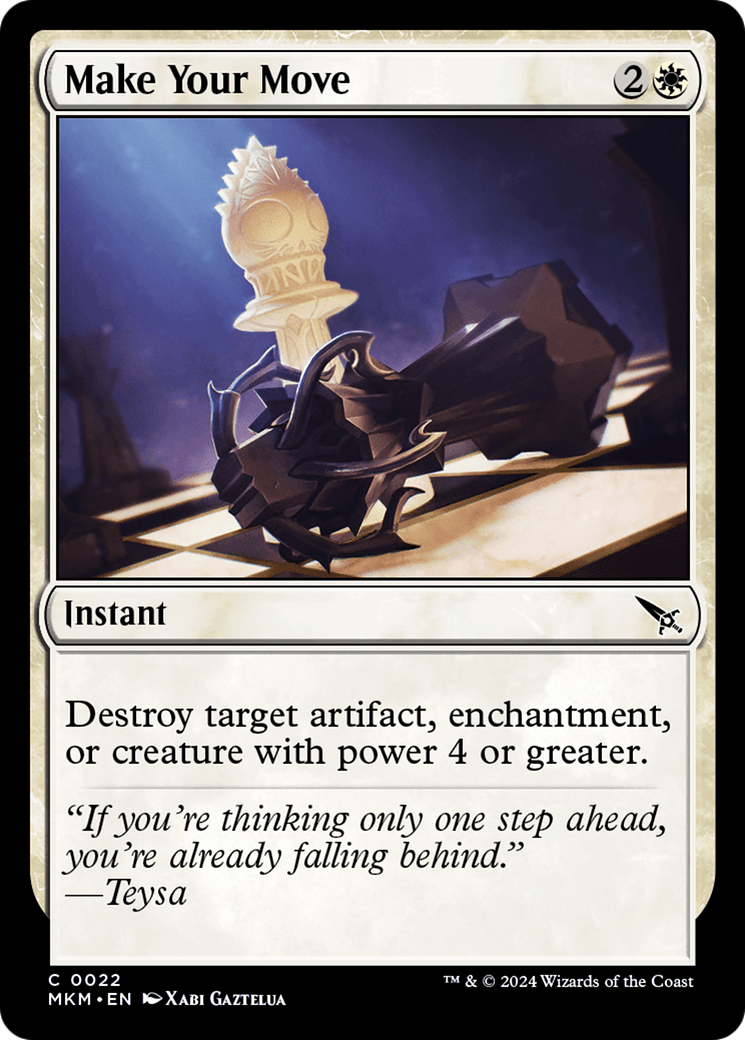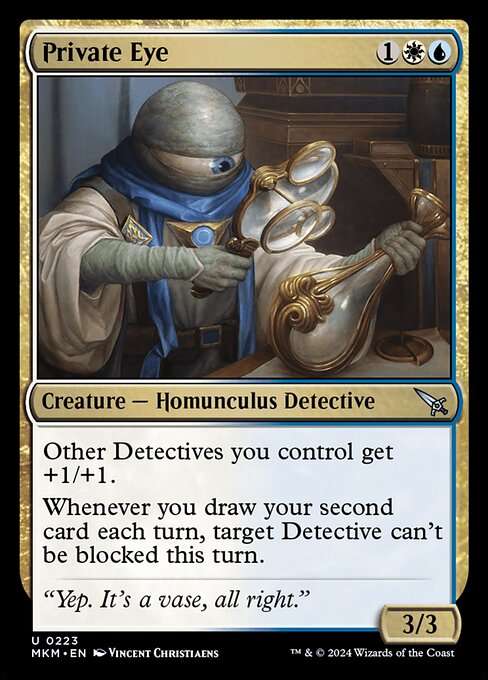There’s Been a Murder!
Everyone, I have some exciting news! There’s been a Murder at Karlov Manor.
We have cases to solve, evidence to collect, and some suspects we need to clear — violently.
We’re going to need to investigate, and figure out what creatures are hiding behind their disguises.
It’s not going to be easy, but I’m going to give you every clue you need to crack this set wide open.
We have here a whole set built around mysteries and deduction – built around a deep mystery unique to the Magic the Gathering universe. By the end of this article, you’re going to have an idea of how Murders at Karlov Manor feels to play, how to deduce what your opponent has, and a significant edge over everyone seeing this set for the first time.
I’m so excited to share everything I’ve learned.
Let’s get into it and start with some numbers.
STATS!
Murders at Karlov Manor has at common and uncommon rarities:
- 100 Creatures (and functional creatures)
- 22 of which have Flying (eight more than LCI)
- 6 with Reach (two more than LCI)
- 8 Creatures with Haste
- 15 Combat Tricks (weirder ones than usual)
- 6 Colorless fixing, four of which are lands




The toughnesses of those creatures are:
- 21 at 1 Toughness
- 36 at 2 Toughness (+30 if you count Disguised creatures)
- 30 at 3 Toughness
- 32 at 4 Toughness
- 11 at 5 Toughness
- 6 at 6 Toughness
- 1 at 7 Toughness
- 2 at 8+ Toughness


So that means:
- The zero cards that deal one damage kill 15% of creatures (wow, nothing?).
- The two two-Damage Removal spells kill 41% of creatures (not counting Disguised creatures).
- The three three-damage spells kill 62%
- The two four-damage spells kill 85%
- The two five-damage spells kill 93%




But there are plenty of other ways to deal with creatures. There are:
- 2 “X damage” removal spells
- 3 board wipes (all rare)
- 1 mana value-based removal spell
- 1 power-based removal spell
- 1 spell that exiles an attacking creature
- 2 Bite spells
- 3 enchantments that remove a creature
- 3 counterspells
- 2 bounce spells
- 3 ways to stun a creature
- 3 creatures that kill creatures upon entering the battlefield
- 5 disenchants (all Selesnya-colored)
- 1 Shatter (red)




Special for MKM, at the common or uncommon rarity there are:
- 26 cards that Investigate
- 7 other Clues
- 30 cards with Disguise
- 22 ways to Collect Evidence
- 14 ways to Suspect a creature
- 3 ways to Un-Suspect it
- 43 Detectives and cards that care about that creature type
- 12 Cases (evaluate separately)
Keep these in mind and refer back to them as you investigate the format!
The Shape of the Format
How is drafting or prereleasing The Murders at Karlov Manor different from Limited in other sets?
Play Boosters
This is the first Magic: The Gathering set to utilize Play Boosters as opposed to Draft Boosters. Here is the full breakdown of what a Play Booster means from Wizards of the Coast, but there are really only four things you need to account for as far as pack structure:
- There is one fewer card per pack
- There are slightly more uncommons relative to commons
- Packs can occasionally have extra rares
- Roughly 14% of packs have an special card instead of a common, either a “guest” card or card from The List

Wizards did an impressive job accounting for these changes at the point of the set’s design, with none of the special cards breaking the format and providing a slight bump in power to Karlov Manor’s most basic cards. Ultimately, you don’t need to change your playstyle anymore than you would for any new set.
Mechanics
(For a complete list of new mechanics, check out the Wizards MKM mechanics guide).
MKM has a few new mechanics and keywords, mostly used in specific color-pairs or archetypes. We’ll discuss Cases, Collect Evidence, Suspect, and Cloak with their relevant archetypes, but the format and strategies are shaped by Investigate.
Investigate as a keyword means simply “create a Clue,” which will usually be a simple token you can cash in for a card later in the game.
Disguise is more complex: a card with disguise can be played face down for three mana as a 2/2 creature with ward two. It can then be “revealed” (turned face up) for its Disguise cost.




33 Common/Uncommon cards make/are Clues and 30 cards have Disguise, which together make up more than a third of the cards you see most often in your Draft or Sealed pool. These two mechanics are found across all five colors to different degrees, and together shape the limited environment as a whole. Players with zero cards in hand will look at a board full of clues and face-down creatures and know that they still have impactful plays to make.
Combat Tricks
Outside of Damage-Based removal and Counterspells, every instant in Murders at Karlov Manor has a completely unique function. There is exactly one instant that grants trample, one that grants Lifelink, one that grants Deathtouch, one that grants First Strike, one that gives three toughness, one that gives two toughness etc. All that is to say, you can figure out what instants your opponent has based on very specific play patterns, and it’s worth having the list as a reference.
So, with all that in mind…
Here’s What Makes Draft and Sealed Events of Murders at Karlov Manor Special:
You have good ways to use mana late in the game.
You don’t need to spend as much deck space on mana sinks or expensive cards, since the mana and time normally spent on those cards will be used sacrificing clues and flipping creatures up.
Significantly more cards are two-for-ones.
Whether it’s a normally strong card with “Investigate” tacked on or a creature that creates more creatures when it’s flipped face up, value will inherently develop over time. To balance this, many of MKMs other cards also produce additional value. You don’t need to waste time casting strict card-advantage spells that say “draw two cards” when the cards you want to play anyway do the equivalent of drawing another.
Removal is bad.
More accurately: “single-target removal is weaker than usual, despite the powerful individual removal spells printed in every color.” In other sets, you can spend a spell to kill your opponent’s first three creatures and then start your game plan. In Murders at Karlov Manor, your opponent’s first creature Investigates, their second creature makes a token when it dies, and their third creature turns face up after you pay the additional two mana for ward. If you spend a turn and a spell on each threat, they’ll replace those cards and likely still have creatures in play. You still need some ways to kill creatures, but prioritize cheap removal to cast the turn you crack a clue or spells that leave behind a little extra value.
Disguised creatures are the standard.
Every creature and removal spell you play needs to be evaluated against a generic three-mana value 2/2 with Ward 2. Two-drop creatures that trade or block Disguised creatures are stronger, and four-mana creatures need to do something amazing if they trade down. All of the color-pair archetypes get additional value out of the variable sizes and mana costs available to creatures, and the lower-risk of splashing a creature with Disguise.
18 lands is the default (instead of 17).
When you have a consistent ability to turn mana into more cards, you need more mana. Your curve will be a little more flexible, because creatures with disguise have multiple costs at which they can be cast and extra mana can be used to crack Clues. Not every deck will need 18 lands, but assume yours does until you have a reason to cut some. MKM features a Clue Land, a Disguise Land, and strong ways to filter cards to help avoid flooding in an 18-land deck.
Deduction is Key.
Slow Clap for WotC
All of these factors come together to create a limited environment that rewards figuring out the instants and face-down cards across the table. Your opponent will be playing differently based on whether their Disguised creature has two or four toughness, which keyword their combat trick grants, and how they’re planning to spend their mana on the following turn. Your opponent won’t attack their 2/2 into your 4/4 if it doesn’t flip up to have four power, and won’t block they think your 2/2 suddenly gain deathtouch.
But let’s take a closer look:
You don’t have to know all of these, but read the one that interests you, or that you think your sealed pool supports!
U/W Detectives
There are 34 Detectives at common and uncommon, making this one easy to build from an unfocused start. You can grab lots of strong early white cards, and decide later to focus more on detectives with Private Eye or the Case of The Pilfered Proof. Ignore strict card advantage, as you’ll end up with more clues than you know what to do with. Focus on spells with low mana costs for anything that isn’t a Detective so you don’t have to take a turn off to crack a Clue.


U/B Clues Control
A strict control deck like we haven’t been able to draft in years. Do your best to pick up every card that says “Investigate” and aim for removal that answers anything. Find time to crack your clues, and deploy a few early blockers to buy that time. As you draft, you have three questions to keep in mind:
- Will my card advantage come strictly from clues, or will I be doing things with my graveyard?
- Are my Disguised creatures blockers or attackers?
- Am I going to win the game by: deploying a creature and making sure it connects or (b)locking things down until my extreme late-game uncommons take things over?


B/R Suspect Aggro
This aggressive deck requires more careful planning than usual. Pay careful attention to which creatures you’re allowed to Suspect with each card and how your opponent is likely to block. If you and your opponent both have two creatures and you have two ways to Suspect a creature, then you can give both of your creatures menace, both of their creatures “Can’t block”, or one each. There’s a careful balancing act of keeping yourself alive as you give up more and more of your ability to block, so calculate your damage each attack and try to pick up ways to take advantage of your opponent having to double-block. Instant-speed removal is stronger if you picked up more large creatures to Suspect, and pump spells are great for trading one of your creatures for two of theirs.


R/G Big Disguise
This color pair is all about flipping up giant Disguised creatures, but the best thing about Disguise is that your opponent has to treat all of them like they’re giant! Pick your enablers, ramp and removal first, as you have a lot of options for the bigger creatures. This color-pair has the most efficiently-costed removal, so try to set up situations where you can deploy a giant threat and remove something from your opponent’s board in the same turn. This is also one of the best archetypes for splashing additional colors. Green has excellent fixing, and you can always cast a creature with Disguise face down until you draw the colors you need to reveal your gigantic attacker.


G/W Go-Wide Disguise
The Disguise aspect as billed isn’t necessary – the only Disguise creatures you really have to look out for are the ones that grow your creatures. From white, you want creatures that generate more bodies by flipping up or coming into play early and ways to grow your team late. The anthems in MKM are powerful and numerous. From green, you want efficiently-sized creatures and ways to keep your creatures alive for a big attack. Prioritize removal that clears blockers and combat tricks that allow you to manipulate their size, as one extra power will often be the difference between a good attack and a bad one.


B/W Pint-Size Disguise (because Wizards won’t say “Weenies”)
Remember that you can still trigger your cards that care about having two power or less with bigger creatures due to Disguise, making this theme stronger than in other sets. You’ll have enough lifegain to ignore any creature that isn’t itself gigantic or generating value for your opponent every turn. Black and white in MKM both have access to huge amounts of efficient single-target removal, so your strong cards that care about having two power or less are a higher priority. Focus on white for the best creatures and black for the cards that care about them.


U/R Artifact Sacrifice
Compared to the other intended archetypes, this one is the easiest to build. Whereas B/R has ten ways to Suspect a creature, U/R artifacts has 21 ways to make self-sacrificing Clues, plus another eight enablers and benefactors. This is a great archetype to prepare to be in and leave if you don’t see either of the two powerful signpost uncommons, as the detectives, cluemakers, and burn spells will all be strong in other decks. This one requires a lot of careful play and planning during the game, but will practically build itself once you have the U/R Uncommons and Investigate cards. As such, your priority during the draft is cheap interaction to keep you alive until your engines take over the game.


R/W Battalion (R/W Aggro)
Calling this “Battalion” is utter nonsense, as only four cards in the set have “whenever you attack with three or more creatures” on them and none of them are red. However, this is still a solid and efficient aggressive deck with incredibly powerful individual cards. Generally look to get your removal from Red and your best early creatures from white, as the white removal spells are much more defensive.


U/G Collect Evidence
Collect Evidence as a mechanic is meant to be something that’s easy to do late in the game. It has no inherent effect, but is instead a cost paid by exiling cards from your graveyard with mana value greater than or equal to the requested amount. I think this is both MKM’s strongest and most difficult-to-assemble archetype. In order of priority, you’ll need:
- Cards that care about Collecting Evidence
- Ways to mill yourself, Surveil, or discard cards
- Cards that collect evidence
- Cheap removal
- Cards that trigger when creatures leave the graveyard
- A way to end the game before you run out of cards (or after!)
This seems like a tall order compared to the other archetypes, but this is also the color pair most adept at splashing a third color. Green’s fixing is strong, blue makes the game go long, and both have enough acceleration to have time to crack Clues. Keep track of which of these things you need, and start looking for what you’re missing in a third color as early as pack two. The value will come naturally as you Collect Evidence, so you actually don’t need to fight for card advantage as aggressively as some of the other color pairs.


B/G Gravebreak
Golgari is here with a new take on using the graveyard: leaving it! There are only four cards that specifically care about leaving the graveyard, but they’re all incredibly powerful to build around and you will often be the only player at a draft table who wants them. Take these payoffs first, and focus on black recursion, green Collect Evidence, and cards that self-enable by exiling themselves from the graveyard.
Due to their being so few cards that actually say “whenever one or more creatures leave your graveyard”, it‘s often correct to build a straightforward midrange green/black deck with creatures and removal, and pick up the payoffs when you see them. Surveil and self-mill are both strong things green can do without the payoffs, and any green decks in MKM are great for splashing missing pieces.


End Step
This product is for me.
Murders at Karlov Manor feels as if it was designed for me to draft. The references are there and the story is fun, but they also managed to design a set that feels like solving a mystery every game. The cards feel new and flexible, the bombs are (mostly) reasonable, and it feels like you can always get a deck together. I’ll be drafting this set more than is healthy, and reporting my findings back to you in the form of my card ranking tier list every week. If you have more questions or want to see me tackling this set all the way through Mythic in MTG Arena, stop by any time at Twitch.tv/ScuffleDLux.
Until I see you again, happy drafting!
